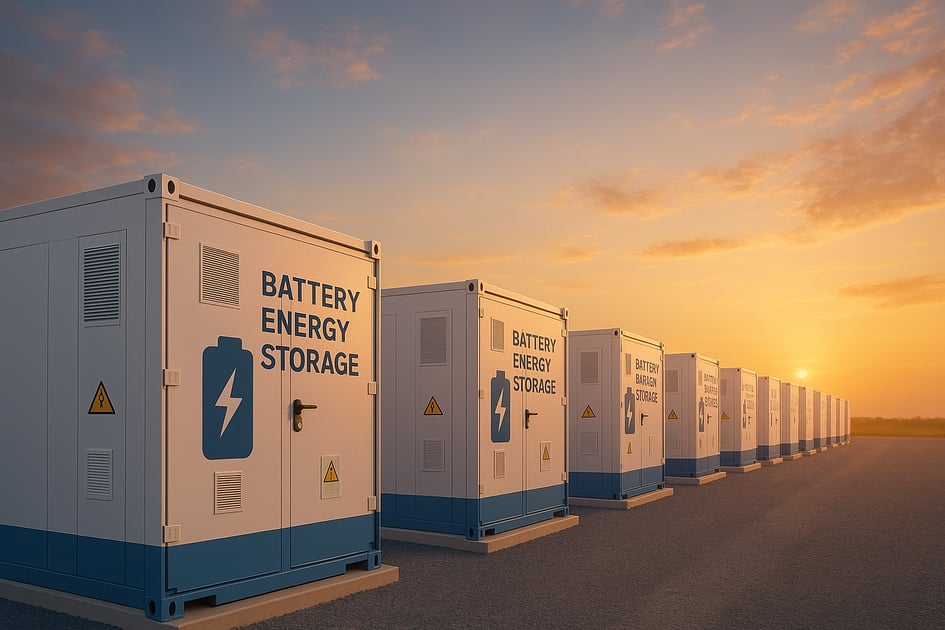Beyond the Charge: The Evolving Landscape of Battery Energy Storage Technology (Part 2)
May 18, 2025 •Greencode

Image created with ChatGPT
From Lithium-Ion Dominance to Software Innovation: In this second installment of our three-part series, we are exploring current solutions and future breakthroughs in Batter Energy Storage Solutions (BESS). The first part of the series covering the market dynamics driving the explosive growth of BESS is available here (Link).
The Technology Behind Battery Energy Storage (BESS): Present and Future
Today's dominant technology for BESS is lithium-ion. When it comes to grid-scale and residential energy storage applications, lithium-ion batteries currently reign supreme. Their dominance stems from several key advantages:
- High energy density: At 150-250 kW/kg, lithium-ion batteries pack more power in less space than alternatives (Asian Development Bank, 2018)
- Superior efficiency: With round-trip efficiency reaching 95%, lithium-ion batteries waste minimal energy during charge/discharge cycles (Asian Development Bank, 2018)
- Improving economics: Costs have fallen dramatically and are projected to decrease by another 60% by 2030 (Asian Development Bank, 2018)
- Eco-friendliness: Compared to alternatives like lead-acid or nickel-cadmium, lithium-ion batteries have a lower environmental impact (Asian Development Bank, 2018)
These characteristics have made lithium-ion the go-to choice for everything from utility-scale installations to home battery systems, with companies like Tesla, BYD, and Fluence deploying gigawatt-hours of lithium-ion storage globally (KfW IPEX-Bank, 2022).
Beyond Lithium-Ion: Alternative Technologies
While lithium-ion dominates today's market, several alternative battery technologies are under development or in testing and show promise for specific applications:
Flow Batteries: Unlike conventional batteries, flow batteries store energy in liquid electrolyte solutions contained in external tanks. Their standout feature is longevity—with lifespans of 20-25 years, significantly outlasting lithium-ion's 10-15 years (Asian Development Bank, 2018). Though they have lower energy density (60-80 kW/kg), flow batteries excel in applications requiring long-duration storage and frequent cycling, such as grid-level energy time-shifting (Asian Development Bank, 2018).
Sodium-Sulfur Batteries: Operating at high temperatures (300-350°C), these batteries offer good energy density (125-150 kW/kg) and moderate efficiency (75-85%) (Asian Development Bank, 2018). They're particularly suitable for grid-scale applications where size constraints are less critical.
Lead-Acid Batteries: Though less glamorous, advanced lead-acid batteries remain relevant for specific applications like uninterrupted power supply (UPS) systems and some residential installations, primarily due to their lower upfront cost despite their shorter lifespan (3-6 years) (Asian Development Bank, 2018).
Differentiating characteristics of different battery technologies (Asian Development Bank, 2018)
Matching Technology to Application
Different BESS applications have distinct technical requirements. System capacity and discharge frequency are particularly important factors in selecting the appropriate technology for an application:
- For frequency regulation requiring rapid response and thousands of cycles annually, technologies like flywheels and supercapacitors excel despite their limited energy capacity (Zhu et al., 2022)
- For household energy storage with modest capacity needs and less frequent cycling, lead-acid or lithium-ion batteries are appropriate (Zhu et al., 2022)
- For renewable integration and energy time-shifting requiring megawatt-hour capacity and moderate cycling, flow batteries and metal-ion batteries offer compelling advantages (Zhu et al., 2022)
The Innovation Pipeline
The BESS technology landscape continues to evolve rapidly. Several promising technologies under development could reshape the market in coming years. Among the most prominent are:
Lithium-Sulfur Batteries: With theoretical energy densities up to five times higher than conventional lithium-ion, these batteries could dramatically increase storage capacity while potentially reducing costs. Cycle life limitations remain a challenge.
Solid-State Batteries: By replacing liquid electrolytes with solid alternatives, these batteries promise improved safety, higher energy density, and longer lifespans. Major automotive and battery manufacturers are investing heavily in this technology.
Zinc-Air Batteries: Utilizing abundant, low-cost materials, zinc-air technology offers promise for large-scale, long-duration storage applications where cost per kilowatt-hour is more important than energy density.
Next-Generation Flow Batteries: New chemistries and designs aim to overcome the energy density limitations of current flow battery technology while maintaining their excellent cycle life and scalability advantages.
It is all about the the Cost Trajectory
The path to mainstream adoption lies within the costs. Over the past 20 years, the most significant technological trend in BESS is the steady decline in costs. According to industry projections, we can expect:
- A 50-66% decrease in energy installation costs across all major battery technologies by 2030 (Asian Development Bank, 2018)
- The sharpest declines in flow battery costs (up to 66% reduction) (Asian Development Bank, 2018)
- Continued improvements in lithium-ion economics (around 60% reduction) (Asian Development Bank, 2018)
This cost trajectory will make BESS economically viable for an ever-widening range of applications, from grid services to behind-the-meter installations for businesses and homes.
The Software Revolution
While hardware innovations capture headlines, equally important and for us as a software-focused green transition VC more relevant are advances occurring in the software layer that controls and optimizes BESS operations. Modern battery management systems (BMS), energy management systems (EMS), and battery intelligence software (BIS) are becoming increasingly sophisticated, employing artificial intelligence and machine learning to:
- Extend battery lifespan through optimized charging/discharging patterns (Energize Capital, 2024)
- Maximize revenue through intelligent participation in multiple market opportunities (Energize Capital, 2024)
- Predict maintenance needs before failures occur (Energize Capital, 2024)
- Optimize system performance based on weather forecasts, energy prices, and consumption patterns (Energize Capital, 2024)
As BESS hardware increasingly becomes commoditized, these software innovations will become the primary differentiators in the marketplace.
The future of battery energy storage looks promising and interesting. As existing technologies mature and new innovations emerge, we can expect BESS to become increasingly powerful, durable, affordable, and intelligent. Referring to the first article in this series, BESS are playing a critical role for accelerating the global transition to a renewable energy future to ensure that power generated from sunlight, wind or tides can be stored and discharged to the grid when needed and not only when available.
In part 3 of this article series, we are looking at the various investment opportunities and value pockets for Venture Capital Investors especially with a digital-first focus like we at Greencode Ventures have.
References
Asian Development Bank. 2018. Handbook on Energy Storage System. DOI:
http://dx.doi.org/10.22617/TCS189791-2. Available under:
https://www.adb.org/sites/default/files/publication/479891/
handbook-battery-energy-storage-system.pdf.
Energize Capital. 2024. Battery Software - An Energize Electrifying Everything
“Deeper” Dive. Available under: https://acrobat.adobe.com/id/urn:aaid:sc:
VA6C2:a579bcf3-e822-4c30-b492-a083839c2a58?viewer%21megaVerb=
KfW IPEX-Bank. 2022. Battery Energy Storage - Value chain integration is key. Flash
Analysis. Available under: https://www.kfw-ipex-bank.de/pdf/Analyses-and
-views/Market-analyses/2022-07-KfW-IPEX-Bank-Flashlight-Analysis-
Zhu, Zhengxin. Jiang, Taoli. Ali, Mohsin. Meng, Yahan. Jin, Yang. Cu, Yi. Chen, Wei.
- Rechargeable Batteries for Grid Scale Energy Storage. In Chemical
Reviews, 2022 122 (22), 16610-16751. DOI: 10.1021/acs.chemrev.2c00289.
Available under: https://pubs.acs.org/doi/10.1021/acs.chemrev.
In the global race toward renewable energy adoption, one technology is on the verge of becoming the critical enabler of this green energy transition: Battery Energy Storage Systems (BESS). As solar panels and wind turbines increasingly dot our landscapes, the challenge of managing their intermittent power generation has brought energy storage to the forefront of the energy revolution.
Why BESS Matters Now More Than Ever
Renewable energy sources are projected to provide more than 45% of global electricity generation by 2030, compared to less than 20% in 2010 (IEA, 2024). Even more drastic is the increase of variable renewables like wind and solar PV that will jump from less than 2% of global electricity generation in 2010 to almost 30% by 2030 (IEA, 2024). This dramatic shift creates a fundamental challenge: while our energy demand follows predictable patterns, renewable energy generation fluctuates with weather conditions and daylight hours.
Global electricity generation by technology, 2000-2030 (IEA, 2024)
The classic example of this mismatch appears in the "duck curve" - as solar energy floods the grid during daylight hours, net demand drops dramatically, only to spike sharply as the sun sets and solar production ceases. This duck curve is particularly distinct for California (US) but shows a trend and the importance of storage. This volatility creates grid instability, market inefficiencies, and ultimately higher costs for consumers.
California Duck Curve (ES Solar, 2025)
BESS addresses these challenges by charging during high supply periods and discharging when needed most. This seemingly simple function delivers multiple critical benefits for the green energy transition:
- Grid stabilization: Enhancing reliability during extreme weather and preventing blackouts
- Peak shaving: Reducing reliance on expensive, high-emission peaker plants
- Renewable integration: Making intermittent renewable sources dispatchable and reliable
- Energy autonomy: Empowering businesses and homeowners to maximize self-consumption of locally generated renewable energy
The Market Is Booming
The numbers tell a compelling story of explosive growth. The global BESS market valued at approximately $44-55 billion in 2023 is projected to nearly triple to $120-150 billion by 2030 (Statista, 2025b).
Among the three major market segments - utility-scale, commercial & industrial (C&I), and residential BESS - utility-scale applications are seeing the most dramatic growth with a projected CAGR of 29% through 2030. This segment is expected to capture 86% of the total BESS market by 2030, driven by massive grid-scale deployments worldwide (McKinsey, 2023).
In Europe alone, BESS capacity has grown from a mere 0.2 gigawatt hours in 2014 to 35.9 gigawatt hours in 2023, with the capacity curve growing increasingly vertical (Statista, 2025a). While the European market has historically been dominated by Germany (33%), Italy (18%), and the UK (17%), we're seeing significant diversification as other European countries accelerate their BESS deployments (Statista, 2025a).
Who's Leading the Charge?
The utility-scale BESS market initially developed as an oligopoly with early movers like Tesla, Fluence (a joint venture between AES and Siemens), Engie, and others capturing 60% of market share in 2020 (KfW IPEX-Bank, 2022). However, the rapid market expansion has created openings for new entrants, evidenced by the top seven players' market share falling to 32% by 2022 (KfW IPEX-Bank, 2022).
This market fragmentation signals opportunity, particularly in the software layer of BESS solutions. As soft costs now account for over 40% of overall BESS unit costs, intelligent software systems for battery management, energy management, dispatch optimization, and predictive analytics have become critical differentiators in the marketplace (Energize Capital, 2024).
Looking Ahead: What's Next for BESS?
The BESS revolution is just beginning. As battery technology costs continue to plummet (projected to fall by 50-66% across various technologies by 2030), BESS installations will become increasingly economical, further accelerating adoption (Asian Development Bank, 2018).
There are interesting developments in second-life battery applications, innovative business models like virtual power plants, and increasingly sophisticated AI-driven optimization platforms that maximize revenue from multiple value streams simultaneously.
For utilities, businesses, and even homeowners, the trend seems to be clear: battery energy storage is no longer an optional add-on to renewable energy systems but a fundamental component of the evolving energy landscape. The question is no longer if but how quickly organizations will adapt to and capitalize on this transformative technology.
Before we go further and look into the value pockets for investing in BESS technologies and particular software applications in part 3 of this blog series, let's dive into the technological landscape of BESS and explore what exactly powers these systems, how the technology is evolving and what's on the horizon in part 2 of our series on BESS.
We are here to invest in and support startups making a difference. Get in touch: hello@greencode.vc
References
Asian Development Bank. 2018. Handbook on Energy Storage System. DOI: http://dx.doi.org/10.22617/TCS189791-2. Available under: https://www.adb.org/sites/default/files/publication/479891/handbook-battery-energy-storage-system.pdf.
Energize Capital. 2024. Battery Software - An Energize Electrifying Everything “Deeper” Dive. Available under: https://acrobat.adobe.com/id/urn:aaid:sc:VA6C2:a579bcf3-e822-4c30-b492-a083839c2a58?viewer%21megaVerb=group-discover.
ES Solar. 2024. Eliminating the Duck Curve in California with Solar and a Battery. Available under: https://essolar.com/blogs/es-solar/eliminating-the-duck-curve-in-california-with-solar-and-a-battery.
IEA. 2024. Renewables 2024 - Analysis and forecast to 2030. Available under: https://iea.blob.core.windows.net/assets/17033b62-07a5-4144-8dd0-651cdb6caa24/Renewables2024.pdf.
KfW IPEX-Bank. 2022. Battery Energy Storage - Value chain integration is key. Flash Analysis. Available under: https://www.kfw-ipex-bank.de/pdf/Analyses-and-views/Market-analyses/2022-07-KfW-IPEX-Bank-Flashlight-Analysis-Energy-Storage.pdf.
McKinsey & Company. 2023. Enabling renewable energy with battery energy storage systems. Available under: https://www.mckinsey.com/industries/automotive-and-assembly/our-insights/enabling-renewable-energy-with-battery-energy-storage-systems.
Statista. 2025a. Energy storage in Europe - statistics & facts. In Statista. Available under: https://www.statista.com/topics/10030/energy-storage-in-europe/#topicOverview.
Statista. 2025b. Market size of battery energy storage systems (BESS) worldwide in 2023, with a forecast until 2030 (in billion U.S. dollars) [Graph]. In Statista. Available under: https://www-statista-com./statistics/1246726/global-battery-energy-storage-systems-market-size-forecast/.

.png)